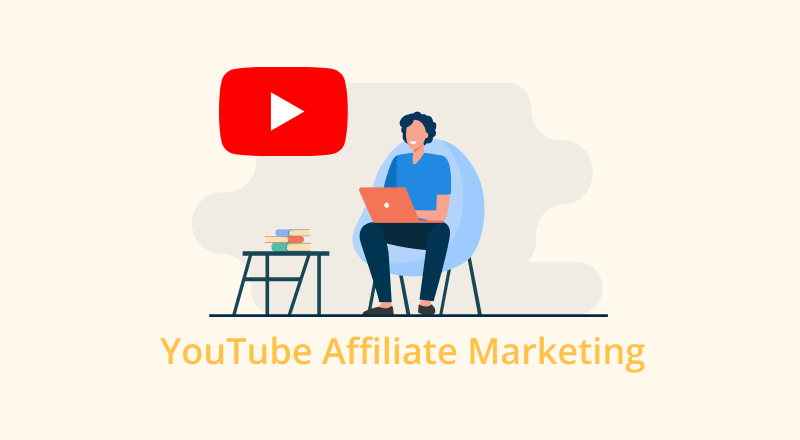
You’ve seen creators online making passive income recommending products. Maybe you’ve thought, “Could YouTube + affiliate marketing be my side hustle?” The short answer: yes. But it takes understanding, effort, and smart strategy. In this guide, I’ll walk you through what works, what doesn’t, and how to build something real.
Table of Contents
What is YouTube Affiliate Marketing?
Why YouTube + Affiliate Programs Can Be Powerful
Key Components of Success (EEAT‑style)
Real Data & Trends in YouTube Affiliate Marketing
How to Begin: Step‑by‑Step Guide
Common Mistakes—And How to Avoid Them
Scaling Up: From One Video to Full Channel Strategy
FAQs: Featured Snippet Style
Conclusion
What is YouTube Affiliate Marketing?
YouTube affiliate marketing is when creators promote products or services in their videos (like reviews, tutorials, comparisons, or “favorites”), include unique tracking links (affiliate links) in their video descriptions (or pinned comments), and earn a commission when viewers click through and make a purchase. YouTube Affiliate Marketing:
You’re not paid by YouTube for those links (unless you combine with AdSense or other monetization), but by the affiliate program or company behind the product.
Why YouTube + Affiliate Programs Can Be Powerful
Let’s talk why many creators choose affiliate marketing on YouTube. These strengths help build revenue and lasting value:
Trust & authority: When a viewer watches your video, hears your voice, sees you test/use a product, it builds credibility. If you do genuine, valuable content, your recommendations matter.
Search / discoverability: YouTube is the 2nd largest search engine after Google. Videos rank, suggestions show up, and over time evergreen content brings in new viewers.
Evergreen income: Videos you made a year ago can still earn affiliate commissions. A review video or tutorial may keep earning.
Low entry cost: You don’t need huge following to start. Even small channels can begin to earn, if the content is well‑targeted and useful.
Multiple content formats: Reviews, unboxings, “best of,” tutorials, comparisons, wishlist videos—all are possible. You can use cards, end screens, pinned comments to remind people of affiliate links.
Key Components of Success (EEAT Style: Expertise, Experience, Authority, Trust)
To build something sustainable (not just a quick buck), these are the pillars that matter:
Expertise
Know your niche. If you’re promoting tech gadgets, you should actually know something about them: specs, use‑cases, what matters to your audience.
Stay up to date: new models, new competitors, pricing, etc.
Experience
Use the product yourself when possible. Share what you like, what didn’t work. Real stories matter.
Show comparisons: “Why I switched from Product A to B” or “Testing it in real‑life”.
Authority
Consistency = authority. Uploading regularly, polishing thumbnails, good visuals, decent sound/video quality.
Engage with your audience: answer comments, do follow‑ups, address questions.
Trust
Transparency: disclose affiliate relationships clearly in the video and description.
Honesty: show both pros and cons; don’t hype a product simply for commission.
Build social proof: user reviews, your own outcomes, maybe direct feedback from viewers who used your recommendation.
Real Data & Trends in YouTube Affiliate Marketing
To show this isn’t just theory, here’s some up‑to‑date data & trends:
Many content creators say that combining product reviews + tutorials increases their affiliate revenue by roughly 30%. Viewers trust content that helps them solve a problem.
wecantrack
+1
Videos that explicitly disclose affiliate links tend to get more trust, and sometimes higher click‑through. Transparency is not just ethical — it’s strategic.
wecantrack
+2
Lasso
+2
Shorter videos (under 10‑15 minutes) with clear, targeted recommendations can perform well, especially if optimized for keyword phrases people search. (But depth still matters.)
wecantrack
+1
Use of end screens, pinned comments, cards is rising among creators as ways to promote affiliate links. These tools help “remind” viewers without being pushy.
EarnKaro
+2
EnactSoft
+2
Forecasts: The number of affiliate‑driven sales coming from video content (YouTube in particular) is expected to grow significantly. More creators will treat affiliate income as a major revenue pillar.
wecantrack
How to Begin: Step‑by‑Step Guide
If you’re serious about making affiliate marketing work on YouTube, here’s a roadmap I’ve seen work, including mistakes I’ve made so you don’t have to.
Step 1: Pick Your Niche & Audience
Choose a specific area you like and know. It could be tech, beauty, fitness gear, productivity tools, cooking appliances, etc.
Understand what problems your audience has: what people are searching for, what pain points they have, what products help.
Keyword research helps: see what people type in search. For example: “best budget earbuds under $50,” “how to choose a blender,” “gaming mouse review.”
Step 2: Join Affiliate Programs
Look for affiliate programs relevant to your niche. Big ones include Amazon Associates, ShareASale, ClickBank, etc., but also smaller niche‑specific programs.
Compare commission rates, cookie durations (how long after someone clicks your link can they buy and you still get credit), payout thresholds.
Check the reputation of programs: timely payouts, quality of product, reliability, whether the company supports affiliates.
Step 3: Plan Content That Converts
Some content types tend to convert better. Here are examples:
Type of Video What Works Best Why It Converts Well
Product Reviews Deep dive into product features, drawbacks, real use People who are considering a purchase want pros & cons
Tutorials / How‑Tos Show how to use product; solve a problem Helps people who want guidance, and also builds trust
Best of / Comparison Videos Compare several similar products; highlight differences Viewers are doing research & want side‑by‑side info
Unboxing & First Impressions Show what you get, check the feel, setup, initial use For new product launches; curiosity drives views
List / Wishlist Videos “Top 5 tools for X”, “Gifts under $100” People looking for curated options; good for seasonal content
Step 4: Optimize for Search & Discovery
Use keyword‑rich titles, descriptions, tags. Include words people search: “review,” “vs,” “best,” “how to,” etc.
Use timestamps in descriptions for longer videos. Helps user experience.
Attractive thumbnails → clean visuals, text overlay with product + benefit.
Use YouTube features: cards, end‑screens, pinned comments to promote affiliate links or relevant content.
Step 5: Disclosures & Ethics
Clearly tell viewers you’re using affiliate links. Use verbal mention or on‑screen text, and in description.
Be honest: show drawbacks. That builds credibility and long‑term trust.
Only promote products you believe in. If something fails badly, your audience loses trust.
Step 6: Track & Measure Performance
Use the analytics tools provided by the affiliate network to see clicks, conversions, what works and what doesn’t.
YouTube analytics: what videos get more watch time, more clicks, higher retention. Videos with good retention usually convert better.
A/B test thumbnails, video formats, placement of affiliate “call to actions” (like mentioning link in video vs only in description).
Step 7: Publish Consistently & Improve Over Time
Set a schedule you can maintain: 1‑2 videos per week or whatever works for you.
Look at comments, feedback, questions from viewers to guide what to cover next.
Refresh old videos: if the product changes or better alternatives exist, update content or make new comparison videos.
Common Mistakes—And How to Avoid Them
These are pitfalls many creators fall into early; avoiding them saves a lot of time and frustration.
Choosing irrelevant products: If your audience is into fitness, promoting unrelated stuff (like kitchen gadgets) might earn commission but cost trust.
Too many affiliate links per video: Can feel spammy, dilute trust. Better to promote fewer high‑quality products well.
Neglecting disclosures: Not only ethical/legal risk, but lack of disclosure undermines trust.
Ignoring video SEO: Good video content won’t help if no one finds it. Titles, thumbnails, descriptions matter.
Poor video quality or sound: Viewers often drop off if audio is bad or lighting is shabby; retention drops, which hurts conversion.
Expecting overnight success: Many creators earn slowly. It takes views, trust, consistent content. Be patient.
Scaling Up: From One Video to Full Channel Strategy
Once you have a few videos up, and you see what works, you can scale. Here’s how:
Diversify Products & Income Streams
Don’t rely on a single affiliate program or product. If it disappears or changes commission, you’re vulnerable.
Introduce digital products (e.g. your own courses, ebooks), or maybe sponsorships once you have audience size.
Optimize Your Funnel
Link to blog posts or landing pages that expand on the video; embed your video there. That helps both SEO and conversion.
Use email lists: get people subscribing, then you can alert them when you publish product‑related content.
Repurpose Content
Short clips, highlights, teaser versions for social media (Instagram, TikTok, etc) that lead back to full YouTube video.
Transcribe videos, make blog posts or summaries for those who prefer reading.
Expand Formats
Live streams with product mentions.
Q&A videos based on audience questions about products.
“Behind the scenes”, “unboxings”, season‑specific gift guides.
FAQs: Featured Snippet Style
Here are quick answers to common questions about YouTube affiliate marketing, in snippet‑friendly format.
What is the easiest way to start affiliate marketing on YouTube?
Pick one niche you’re knowledgeable about.
Join one or two affiliate programs that match your niche.
Make a product review or tutorial video.
Include your affiliate link in the description (and disclose it).
Promote the video and gather feedback to improve.
Do I need many subscribers before affiliate links make sense?
No, not necessarily. Affiliate marketing can work even if your channel is small, provided your content is well‑targeted, helpful, and discoverable. What matters more is view count, search traffic, and how well you match product to audience, rather than just subscriber numbers.
Which affiliate products convert best on YouTube?
Products people research before buying: tech, gadgets, gear, tools.
Evergreen products (those people need year after year).
Products with good visible features or comparison points.
Items with enough profit margin or recurring commissions.
How much can a creator realistically earn from affiliate links on YouTube?
It varies widely: depending on niche, traffic, conversion, product price, commission rates. Some creators make a few hundred dollars/month; others make thousands. Growth tends to be slow initially, then increase as you build trust, content library, and optimization.
Is affiliate marketing on YouTube legal / do I need to disclose?
Yes, it’s legal, but you must follow disclosure rules / advertising regulations. Mention that some links are affiliate links. Be transparent in video and description. Failure to do so can harm trust or even lead to penalties depending on jurisdiction.
Conclusion
YouTube affiliate marketing is not just a trend—it’s a real way creators are earning meaningful income. But the ones who succeed are those who combine trust, value, consistency, and smart optimization.
If I were starting today, this is what I’d do:
Pick a niche I know well and care about.
Start with honest product reviews or tutorials so I can build trust.
Optimize every video for search, thumbnails, descriptions, and always disclose affiliate links.
Be consistent, learn from feedback, refresh content.
Diversify: different affiliate programs, maybe my own products or sponsorships later.
Want me to pull up some niche‑ideas or profitable affiliate programs for your channel (your interests), so you have a personalized roadmap?
